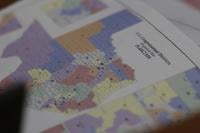When Democratic lawmakers fled Texas to try to prevent the Republican-led Legislature from redrawing the state's congressional districts, it marked the latest episode in a long national history of gerrymandering.
The word “gerrymander" was coined in America more than 200 years ago as an unflattering means of describing political manipulation in legislative map-making.
The word has stood the test of time, in part, because American politics has remained fiercely competitive.
Who is responsible for gerrymandering?
In many states, like Texas, the state legislature is responsible for drawing congressional districts, subject to the approval or veto of the governor. District maps must be redrawn every 10 years, after each census, to balance the population in districts.
But in some states, nothing prevents legislatures from conducting redistricting more often.
In an effort to limit gerrymandering, some states have entrusted redistricting to special commissions composed of citizens or bipartisan panels of politicians. Democratic officials in some states with commissions are now talking of trying to sidestep them to counter Republican redistricting in Texas.
How does a gerrymander work?
If a political party controls both the legislature and governor’s office — or has such a large legislative majority that it can override vetoes — it can effectively draw districts to its advantage.
One common method of gerrymandering is for a majority party to draw maps that pack voters who support the opposing party into a few districts, thus allowing the majority party to win a greater number of surrounding districts.
Another common method is for the majority party to dilute the power of an opposing party’s voters by spreading them among multiple districts.
Why is it called gerrymandering?
The term dates to 1812, when Massachusetts Gov. Elbridge Gerry signed a bill redrawing state Senate districts to benefit the Democratic-Republican Party. Some thought an oddly shaped district looked like a salamander. A newspaper illustration dubbed it “The Gerry-mander” — a term that later came to describe any district drawn for political advantage. Gerry lost re-election as governor in 1812 but won election that same year as vice president with President James Madison.
Is political gerrymandering illegal?
Not under the U.S. Constitution. The Supreme Court, in a 2019 case originating from North Carolina, ruled that federal courts have no authority to decide whether partisan gerrymandering goes too far. Chief Justice John Roberts wrote: “The Constitution supplies no objective measure for assessing whether a districting map treats a political party fairly.”
The Supreme Court noted that partisan gerrymandering claims could continue to be decided in state courts under their own constitutions and laws. But some state courts, including North Carolina's highest court, have ruled that they also have no authority to decide partisan gerrymandering claims.
Are there any limits on redistricting?
Yes. Though it's difficult to challenge legislative districts on political grounds, the Supreme Court has upheld challenges on racial grounds. In a 2023 case from Alabama, the high court said the congressional districts drawn by the state's Republican-led Legislature likely violated the Voting Rights Act by diluting the voting strength of Black residents. The court let a similar claim proceed in Louisiana. Both states subsequently redrew their districts.
What does data show about gerrymandering?
Statisticians and political scientists have developed a variety of ways to try to quantify the partisan advantage that may be attributable to gerrymandering.
Republicans, who control redistricting in more states than Democrats, used the 2010 census data to create a strong gerrymander. An Associated Press analysis of that decade's redistricting found that Republicans enjoyed a greater political advantage in more states than either party had in the past 50 years.
But Democrats responded to match Republican gerrymandering after the 2020 census. The adoption of redistricting commissions also limited gerrymandering in some states. An AP analysis of the 2022 elections — the first under new maps — found that Republicans won just one more U.S. House seat than would have been expected based on the average share of the vote they received nationwide. That was one of the most politically balanced outcomes in years.









